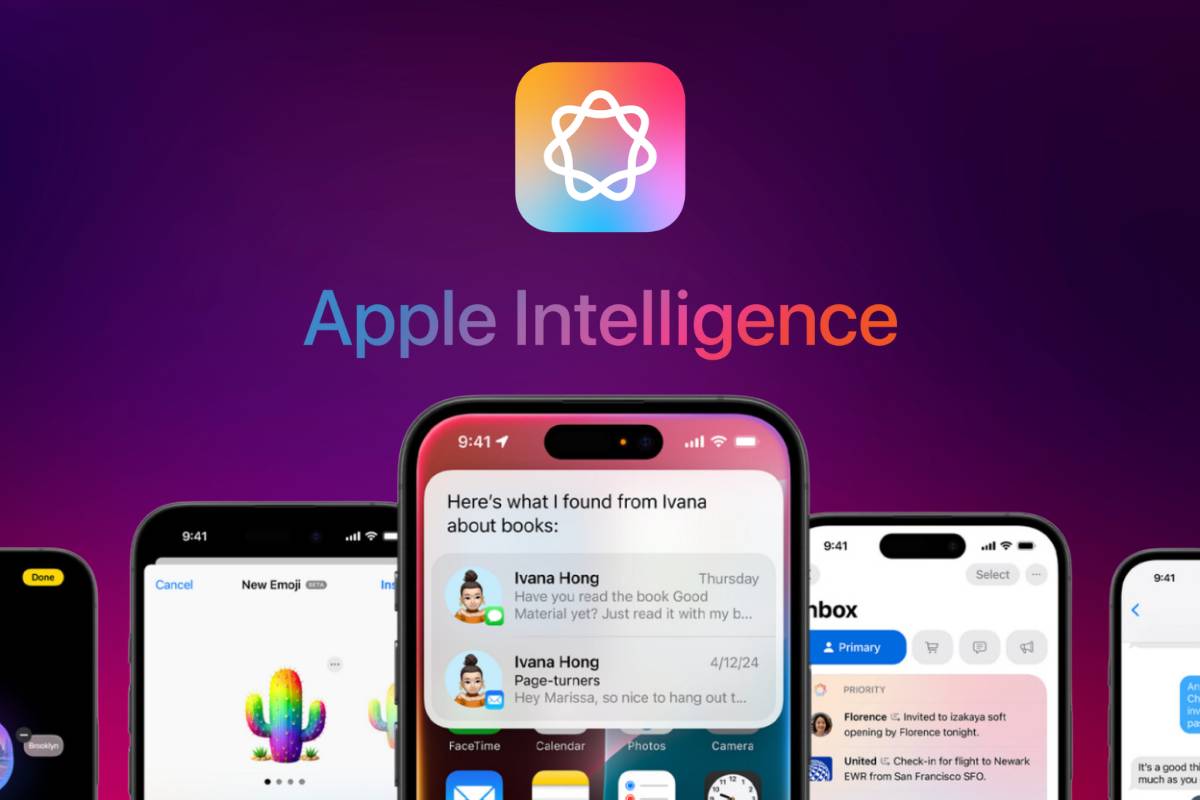Apple has been at the forefront of artificial intelligence, and its software, Apple Intelligence, is the main reason for this change. This isn’t just adding new features; it’s a huge change in how Apple devices understand and talk to people to make everyday tasks easier and more seamless. Let’s look at the different ways Apple is trying to improve Apple Intelligence, from big investments to targeted acquisitions and cutting-edge research.
Big Investment in the Future of AI
Apple knows that AI is more than just a passing trend; it’s the future of technology. Their huge financial investments show this. The company has said that it wants to invest more than $500 billion in the US over the next four years. A large part of this huge amount will go toward artificial intelligence, silicon engineering, and the infrastructure needed to support these projects. Apple sees AI as a key part of their future product strategy, not just a nice-to-have feature, which is why they are investing this much.
Apple is also actively making Apple Intelligence available to everyone. They began with US English and quickly added support for more languages and regions. Features are now available in languages like French, German, Italian, and Simplified Chinese, as well as in places like the European Union and India. This proactive step shows that Apple wants Apple Intelligence to be a technology that is available to everyone, no matter where they are.
Defining Apple Intelligence: Beyond a Buzzword
Apple Intelligence is the integrated collection of artificial intelligence and machine learning capabilities for the company, built to make the user experience better across its enormous hardware and software ecosystem. This robust platform powers a variety of features intended to simplify and enhance everyday life, such as smart writing capabilities, the creative creation of images, and dramatic improvements to Siri, the company’s virtual assistant.
A defining feature of Apple’s Apple Intelligence strategy is its intense focus on processing information locally on the device. This approach reflects their absolute dedication to user privacy and security, a distinct competitive advantage in an industry where its competitors are frequently dependent upon cloud-based AI processing. In the competitive tech world of today, artificial intelligence plays a vital role, and Apple understands that it must keep innovating its AI features to retain its competitive advantage. Apple sets Apple Intelligence as a central pillar of its value proposition for products, with the emphasis on providing real benefits to users while protecting their privacy intensely.
Recent Advances: Enlarging Features and Reach
Apple has been busy broadening the capabilities and reach of Apple Intelligence in recent software releases. One major milestone was achieved in April 2025, as Apple Intelligence features were introduced in a variety of new languages, such as French, German, Italian, Portuguese (Brazil), Spanish, Japanese, Korean, and Simplified Chinese. The expansion also introduced these smart features to iPhone and iPad users in the European Union for the first time. Also, Apple Intelligence is now launched on Apple Vision Pro for the first time, starting in U.S. English.
Latest releases of Apple operating systems like iOS 18.4, iPadOS 18.4, and macOS Sequoia 15.4 have ushered in all-new features empowered by Apple Intelligence. They encompass:
- Priority Notifications: Smarter filtering and promotion of the most important messages to prevent you from missing the crucial ones.
- Memory Movies on Mac: Mac users can now easily make customized memory movies out of their videos and photos with just a description.
- More Advanced Image Playground: The Image Playground option has also been upgraded with a new Sketch style, giving more flexibility for users to create different images.
- ChatGPT Integration: OpenAI’s ChatGPT has been implemented in the system-wide Writing Tools, enabling users to write from scratch, and in Siri, enabling improved conversational capabilities.
This staged introduction of features and widening of accessibility reflect a planned and incremental approach to rolling out Apple Intelligence. The implementation of third-party AI models such as ChatGPT indicates Apple’s openness to incorporating outside expertise in order to enrich the user experience within its own ecosystem.
The Specialized Teams Leading AI Developments at Apple
In the background, Apple has built a strong organizational framework committed to exploring, innovating, and implementing artificial intelligence and machine learning technologies. The fact that there is a dedicated “AIML” department, made up of multiple specialized sub-teams, reflects the significance Apple attributes to this area. Under this department, certain teams are dedicated to key sectors, including:
- Health AI: Investigating the use of machine learning to solve health-oriented issues.
- Intelligent System Experiences: The developers behind advanced features such as Genmoji, Image Playground, and Image Wand.
- Siri and Information Intelligence: Focused on making Apple’s virtual assistant and other intelligent services better.
New leadership appointments at Apple’s AI team suggest continued attempts to better develop the company’s strategy within this fast-paced field. Kim Vorrath, an experienced software executive with a reputation for turning around difficult projects, has been hired to assist in bolstering the work on Siri and Apple’s AI foundation. This was followed by a leadership change for the Siri project, with Craig Federighi, software engineering leader, assuming greater responsibility in conjunction with Mike Rockwell, who was instrumental in the creation of Apple Vision Pro. These organizational changes imply a forward-looking approach to optimizing the direction and performance of Apple’s AI initiatives.
Decoding Apple’s AI Ambitions Through Job Postings
Examining Apple’s recent job postings reveals insightful information about the exact skills and expertise the company is presently looking to advance its AI and machine learning initiatives. Positions like Machine Learning Research Scientist in Health AI reveal Apple’s interest in harnessing AI for breakthroughs in the health space. The role of a Multimodal Generative Modeling Research Engineer reflects a strategic emphasis on driving capabilities in innovative areas such as generative AI and multimodal models, essential to offerings such as image and text creation.
Apple also wants Software Engineers in machine learning for robotics research, which indicates a look into AI uses outside its typical product lines. In addition, hiring a Senior Machine Learning Manager for Ad Platforms and a Senior Engineering Manager for the Knowledge Graph indicates the significance of AI in enriching Apple’s ad services and enhancing the underlying data structures that drive smart features.
Core areas of skill stressed regularly in these job descriptions are:
- A solid background in deep learning and reinforcement learning.
- Hands-on experience in natural language processing and speech technologies.
- Specialization in computer vision.
- Specialization in on-device machine learning.
- Skills with industry-leading frameworks such as TensorFlow and PyTorch.
The scope of these roles, from basic research to applied engineering and strategic management, suggests an integrated strategy of not merely innovating in AI but successfully applying those innovations to concrete product attributes and services.
Experiencing Apple Intelligence: Features in Action
Apple’s latest software releases aptly illustrate the concrete fruits of their constant efforts in refining Apple Intelligence. The launch of iOS 18.4, iPadOS 18.4, and macOS Sequoia 15.4 was a major milestone in the rollout of Apple Intelligence features to more of the world, with the inclusion of support for many new languages. Apple Intelligence was also introduced to the Apple Vision Pro for the first time, enabling users to enjoy features such as Writing Tools and Image Playground on this groundbreaking platform.
In addition to expanded language capabilities, these updates added a number of new AI-driven features:
- Writing Tools: Accessible throughout the operating system, these tools allow users to proofread, rewrite, and summarize text in many applications. Integration with ChatGPT takes these abilities even further, enabling users to create text from scratch.
- Image Playground: Provides an easy-to-use interface for creating playful and creative images, with the addition of a Sketch style in recent releases broadening creative options.
- Genmoji: Enables users to create their own personalized emojis to suit every conversation, putting a personal touch to communication.
- Priority Notifications: Smartly brings the most significant notifications to the surface, making it easier for users to handle the rising number of notifications.
- Memory Movies: For Mac users, the possibility of creating personalized memory movies from their photos and videos by simply giving a text description presents a new and simple means of reliving their memories.
- Improved Siri: Siri has been dramatically improved with features such as enhanced natural language understanding, a revamped interface, and the capacity to easily integrate with ChatGPT to provide richer responses.
- Smart Photos App: Enriched by AI-based features such as natural language search, enabling users to search for specific photos and videos by explaining what they want to see, and the Clean Up feature, which allows them to eliminate distracting objects from pictures.
- Focus and Notifications: Functionality such as Reduce Interruptions, Focus, and smart notification summaries again illustrate Apple’s dedication to utilizing AI to make users more productive and better able to deal with information.
The richness and extent of these AI-driven capabilities integrated into Apple’s foundational operating systems and applications indicate a strategic initiative to make AI a ubiquitous and inherent part of the user experience.
Aiding the AI Knowledge Base: Research and Academia
Apple also proactively interacts with the wider artificial intelligence research community via the release of research papers and partnerships with universities. These research papers span numerous AI areas, such as advances in machine translation, novel computer vision models, and natural language processing techniques. Apple has further participated in open-source AI through the release of pre-trained models and datasets on platforms such as Hugging Face, encouraging collaboration and knowledge exchange among the AI community.
One of the highlights of Apple’s interaction with academia is the Apple Scholars in AIML PhD fellowship program. This program fosters upcoming leaders in academic research by offering funding, mentorship by Apple researchers, and internship experiences. The program partners with universities globally, supporting innovation in a range of AI specializations. The various areas of research sponsored by this fellowship are a broad representation of Apple’s interest in the domain, including:
- AI for Health and Wellness
- AI for Accessibility
- Privacy-Preserving Machine Learning
- ML Algorithms and Architectures
- Human-Centered AI
- Human-Machine Collaborative Visual Generation and Editing
- Speech and Natural Language
- AI for Ethics and Fairness
- Computer Vision
- Data-Centric AI
- ML Theory
- Information Retrieval, Ranking, and Knowledge
- Embodied ML
With these research contributions and academic collaborations, Apple shows not only a commitment to applying AI but also to contributing to its development.
Strategic Acquisitions: Fueling AI Growth
Apple has taken a proactive approach to buying AI-related startups and companies to expedite its artificial intelligence developments. One such acquisition is DarwinAI, a Canadian startup that is focused on reducing the size and increasing the speed of AI systems, which perfectly fits Apple’s emphasis on processing AI within the device itself. This acquisition implies a strategic step towards making AI models more efficient and performing better when directly running on Apple devices.
Another notable acquisition was Voysis, an Irish AI startup that works on enhancing natural language understanding in digital assistants, presumably to upgrade the capabilities of Siri. Apple is also reportedly eyeing the acquisition of Brighter AI, a German startup whose technology can be used to enhance user security and privacy for the Apple Vision Pro, reflecting a focus on incorporating AI to enhance certain product features.
Industry reports also show that Apple has been specifically busy acquiring AI startups, with one report citing that they purchased up to 32 AI startups in 2023 alone. This large number of acquisitions shows Apple’s aggressive strategy of accessing top talent and innovative technologies within the fast-changing AI environment.
Expert Opinions: Breaking Down Apple’s AI Path
Industry experts provide varying opinions regarding Apple’s plan for enhancing Apple Intelligence. A common thread running through the pieces is Apple’s focus on user privacy and in-device processing as major differentiators. The experts point out that this focus lines up with Apple’s tradition of safeguarding users’ data and offers a market differentiator to competitors that also depend so heavily on cloud AI processing. Analysts also point out the potential benefits Apple derives from its highly integrated hardware and software ecosystem, enabling optimized performance and effortless user experiences with AI-enabled features.
Nonetheless, there have been some concerns raised by experts regarding Apple’s AI progress relative to industry leaders such as Google and Microsoft, especially in voice assistant applications. The lag in the full-scale revamp of Siri, for instance, has been cited as a possible drawback. However, most analysts recognize Apple’s past “wait and perfect” approach, implying that even though Apple might not necessarily be the first to market with new AI capabilities, its emphasis on providing a refined and intuitive experience might ultimately result in more effective and widely used solutions. Apple Intelligence’s long-term vision is being viewed as one of broader integration between Apple’s product offerings, with big potential to transform future products such as augmented reality hardware and generate completely new kinds of user experience.
The Competitive Landscape: Apple Intelligence vs. the Rest
When looking at Apple Intelligence relative to its chief competitors’ AI offerings, there are a few important differences and similarities that arise. Google’s Gemini and Samsung’s Galaxy AI are leaders in the mobile AI field. For example, in image editing, Samsung’s Galaxy AI has been mentioned to be highly effective in removing objects, possibly utilizing cloud computing, whereas Apple initially concentrated on processing within the device with its Clean Up tool. Nevertheless, Apple highlights the privacy benefits of its on-device solution. In text summarization, Apple Intelligence already has a wider range of features, which can summarize websites, emails, and notes, while Google’s Gemini is more integrated into its apps, such as Gmail. Both systems provide voice recording, transcription, and summarization, and the capability to create smart replies in messaging and email.
Microsoft’s Copilot offers a competing environment centered on productivity in business settings via integration with the Microsoft 365 platform. While Apple Intelligence targets ease of integration into the Apple ecosystem with a focus on user privacy and user-friendliness, Microsoft Copilot utilizes powerful AI models to automate processes and offer data analysis, largely dependent on cloud infrastructure. One major plus point for Apple is its neural processors built into Apple Silicon that are specifically crafted to speed up machine learning tasks on its products to provide swift, secure, and power-efficient AI operations. Additionally, the profound integration of AI in all aspects of Apple’s hardware and software ecosystem, along with its emphatic commitment to user privacy, delivers a distinct competitive advantage in an era where such factors are sought more and more.
The Road Ahead: Apple Intelligence in the Future
Apple is working hard to keep Apple Intelligence up to date and make it much better through research, development, and buying other companies. The fact that they keep adding more languages and regions shows that they want to make these smart features available to more people around the world.
Apple Intelligence will likely mean even more integration into the Apple ecosystem in the future. Siri is still being worked on, and new features like more contextual awareness and support for multiple apps are on the way. Apple’s plan also includes adding new AI-powered features to all of its apps, such as better features for the Photos app and better ways to manage notifications. Apple is trying to carve out a niche in the AI space by focusing on user privacy and its strong skills in integrating hardware and software. This is especially important in a crowded market with established competitors. According to future trends, Apple Intelligence will become an even more important part of how people use all Apple devices. The company will continue to focus on providing cutting-edge AI features while upholding its core values of privacy and security.
















